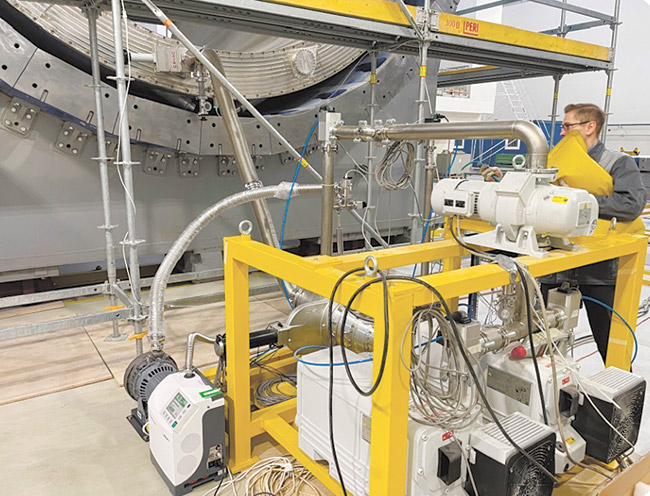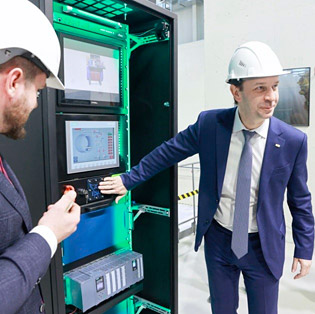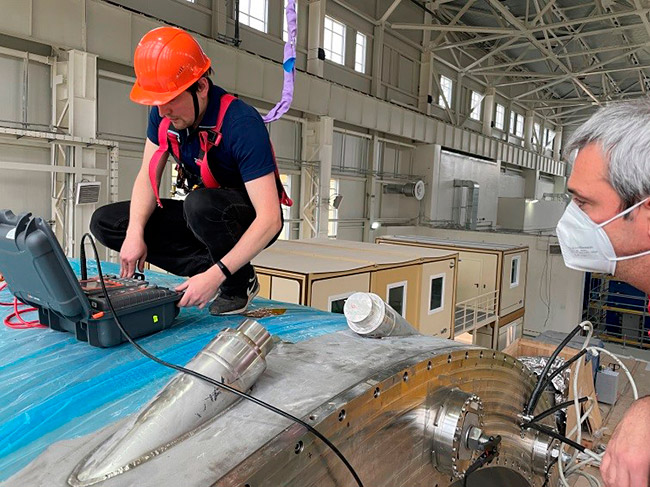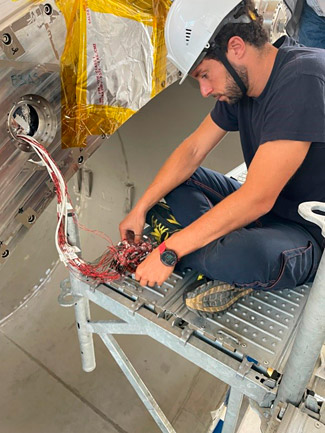
Electronic english version since 2022 |
The newspaper was founded in November 1957
| |
|
Number 22 (4619) |
Projects of the 20th century
MPD: on the way to the goal
Coming together is the beginning. Keeping together is progress. Working together is success.
Henry Ford
At the beginning of last year, our newspaper reported on the successful completion of the test assembly of the magnetic circuit of the solenoidal spectrometric magnet of the MPD facility of the NICA complex. We asked VBLHEP Deputy Chief Engineer K.A.Mukhin to tell us about what kind of work had been carried out after that, about their status today and what needed to be done in the future.
To the reader, perhaps, such a narrative will seem overloaded with technical details. On the other hand, it will make an impression of the complexity and variety of the work carried out on the NICA mega-science project. After all, in this case we are talking about only one stage of one of the areas of a large project. Especially important in such processes is the coherence of the activities of all responsible services, departments, specialists involved in these activities - this is the only way to overcome the difficulties that arise, the only way forward is possible.

"Konstantin Aleksandrovich, what happened next after the installation of the solenoid into the magnetic circuit?"
"The engineers of the ASG Company (Genoa) carried out computer simulation of the magnetic field. It was implemented to determine the impact of deviations that occurred when installing the solenoid into the magnetic circuit. The values were obtained within the tolerance and amounted to no more than 0.5 mm along the vertical axis and 2.4 mm from the nominal value along the horizontal axis. According to the manufacturer, the ASG Company, these deviations did not affect the uniformity of the magnetic field and additional adjustment of the position of the solenoid in the magnetic circuit was not required. Therefore, the solenoid was fixed in this position and preparations for its testing started."
"What should have been done next to prepare the magnet for operation on physical experiments?"
"Before putting the magnet into operation with cooling down to 4.5 K and starting magnetic measurements, it was necessary to implement a large operation cycle on assembling the solenoid and its elements: to carry out strength and leak testing, to perform electrical tests, to assemble and test the cryogenic system, as well as to assemble and connect the water cooling of the solenoid power supply systems."
"Which of them have already been completed?"
"First of all, these are activities including strength and leak testing on the solenoid and cryogenic pipelines, on the integrity of the superconducting cables of the solenoid winding, on the operability of connectors, temperature and voltage sensors located inside the solenoid."
"Tell us more about how such complex many-component systems are tested, please."
 "The solenoid tests involve leak testing on the vacuum volume of the solenoid, testing on the nitrogen thermal shield loop, as well as strength and leak testing on the liquid helium circulation loop. The tests are carried out using the vacuum method at the background value of the leak detector no worse than 2·10-8 mbarl/s and at a pressure not exceeding 5·10-4 mbar in the solenoid volume. These requirements are given by the manufacturer and allow one to determine even minor leakages. The integrity testing on the vacuum volume of the solenoid was carried out by blasting helium from the outside all the welds, as well as the blind flanges that had been installed instead of transport pins to protect all internal equipment, thermal bridges, supports and pipelines (all this is called "cold mass" in the documents) from damage during transportation. If helium enters the pumped volume, the helium molecules are detected using the leak detector. For the leak testing on the nitrogen and helium loops, helium is supplied inside each of them at a pressure of 10 and 25 bar, respectively. In case of a leakage, helium will also enter the pumped volume and the leakage will be detected. The pressure during testing exceeds the operation pressure by 1.5 times that indicates an additional margin of strength of the product."
"The solenoid tests involve leak testing on the vacuum volume of the solenoid, testing on the nitrogen thermal shield loop, as well as strength and leak testing on the liquid helium circulation loop. The tests are carried out using the vacuum method at the background value of the leak detector no worse than 2·10-8 mbarl/s and at a pressure not exceeding 5·10-4 mbar in the solenoid volume. These requirements are given by the manufacturer and allow one to determine even minor leakages. The integrity testing on the vacuum volume of the solenoid was carried out by blasting helium from the outside all the welds, as well as the blind flanges that had been installed instead of transport pins to protect all internal equipment, thermal bridges, supports and pipelines (all this is called "cold mass" in the documents) from damage during transportation. If helium enters the pumped volume, the helium molecules are detected using the leak detector. For the leak testing on the nitrogen and helium loops, helium is supplied inside each of them at a pressure of 10 and 25 bar, respectively. In case of a leakage, helium will also enter the pumped volume and the leakage will be detected. The pressure during testing exceeds the operation pressure by 1.5 times that indicates an additional margin of strength of the product."
To carry out these tests, the employees of MPD Scientific and Experimental Department together with their colleagues from FLNP developed and agreed with ASG on a test scheme and manufactured a test bench, including vacuum equipment, safety and control valves, adapters and flanges for connecting the system to the tested volume.
The vacuum solenoid system has been tested and adapted for testing. The MPD Engineering Support Sector has developed a programme for automatic control of the vacuum system that prevents equipment failure or solenoid loss of sealing during testing.
The tests have been carried out by JINR specialists in the presence of an inspector from ASG. And the start of these tests has been given by JINR Director Grigory Vladimirovich Trubnikov.
"What can be said about the results?"
"The test results have showed that the vacuum volume and the flanges installed at the ends are sealed. The helium loop also has successfully passed the leak test. However, the nitrogen loop failed the test; JINR specialists discovered a leakage on the tee-joint, in the welded joint of the copper pipeline. ASG and JINR specialists jointly developed and agreed on a leakage prevention programme. Subsequently, the leakage was stopped and repeated testing showed the sealing of the loop within the specified parameters."
"What other work has been done?"

"In addition to strength and leak tests, specialists of the Group No.2 Protection of Electrical Devices headed by Nikolai Anatolievich Filippov have also carried out electrical tests of the integrity of the superconducting winding of the solenoid, as well as the absence of contact between the winding and the solenoid housing.
 At the same time, the specialists of MPD Engineering Support Sector of MPD SED, together with ASG representatives, tested the operability of the connectors located at the ends of the solenoid, from which control and information signals are transmitted to the monitoring and control system. Temperature and voltage sensors were also tested. It is worth noting that it was very painstaking and responsible work. In total, about 450 cables were tested for integrity. While testing the connectors, it was determined that one of them had failed and needed to be replaced. The connector replacement work was carried out by ASG specialists. A follow-up testing after the replacement showed that all the sensors and connectors were fully operational.
At the same time, the specialists of MPD Engineering Support Sector of MPD SED, together with ASG representatives, tested the operability of the connectors located at the ends of the solenoid, from which control and information signals are transmitted to the monitoring and control system. Temperature and voltage sensors were also tested. It is worth noting that it was very painstaking and responsible work. In total, about 450 cables were tested for integrity. While testing the connectors, it was determined that one of them had failed and needed to be replaced. The connector replacement work was carried out by ASG specialists. A follow-up testing after the replacement showed that all the sensors and connectors were fully operational.
In addition, work is underway in the premises adjacent to the accelerator tunnel. There the contractors, under the supervision of CCD and the responsible JINR employees, continue to install the water cooling system for the power supply of the solenoid and its correcting coils. The coolant of the cooling loop will be the demineralized water circulating in a closed loop. Heat removal will take place in plate heat exchangers.
"Tell us about your future plans, please. What are your specialists going to do?"
"According to the plans, we were supposed to start installing low-current solenoid cables, followed by testing their operational capability. This work was slightly delayed, since ASG was unable to deliver the remaining 2 out of 18 cables to JINR. In this regard, it was decided to prepare the connectors and cables on their own in order to minimize the project delay. Considering the high qualification of the employees of the MTD department involved in this work, I think that by the time this article is published, the work mentioned above will have been completed. Also, the next important step is the assembly of the solenoid connection unit to the control dewar (chimney unit), that is an intermediate link between the cryogenic cooling system and the solenoid. Difficulties also arose here due to the fact that ASG did not provide these units to JINR, although they should have done it. This is a very important unit, and after its installation according to the design proposed by ASG, access to it will be limited and difficult. The ASG documentation assumed access to this unit only after the complete disassembly of all equipment, depressurization of the loops and the vacuum jacket of the entire magnet system. Thus, in the event of a need for repair or access to this node, the operation of the magnet would have to be stopped for at least 6 months. This approach seemed irrational to us, and together with VBLHEP Deputy Chief Engineer Nikolai Topilin and design engineer Sergey Gerasimov, we developed a new assembly, the design of which will allow one to have access both to the vacuum casing and to the internal pipelines of the unit without large-scale disassembly of cryogenic equipment and upper platform as a whole. All individual parts will be manufactured in VBLHEP workshops. After partial assembly of the "chimney unit" and carrying out procedures for strength and leak testing on the unit, the assembly of the magnetic circuit will be carried out (installation of support rings, beams and the upper platform for cryogenic equipment). After assembly, measurements on the position of the entire structure (magnetic circuit + solenoid) for the final determination of deviations will be implemented.
In parallel with this, JINR specialists develop and agree on a work plan for assembling the corrective magnet coils and installing them in the poles. All the activities mentioned above are scheduled to be completed by the end of July 2022. Also in parallel, testing and assembly of the main units of the cryogenic solenoid cooling system, such as a refrigerator and nitrogen supply systems to the screen are underway. Given the current situation with supplies from the EU, we actively work to reorient orders to Russian markets. Despite all the difficulties that arise, I am sure that we will be able to complete the task and start cooling the magnet, as well as conduct an initial measurement of the magnetic field in November-December 2022.
In conclusion, I would like to thank Directorate of the Laboratory of High Energy Physics for their support in our work, as well as the employees of the Scientific and Experimental Department of the Multipurpose Detector, the Design Bureau, workshops, the Scientific and Engineering Department of Nuclotron Power Supply Systems, other departments of VBLHEP, Procurement & Logistics Service of JINR that professionally perform their duties and help to understand all the intricacies of the operation and testing of equipment within their area of competence."
The material was prepared by Galina MYALKOVSKAYA